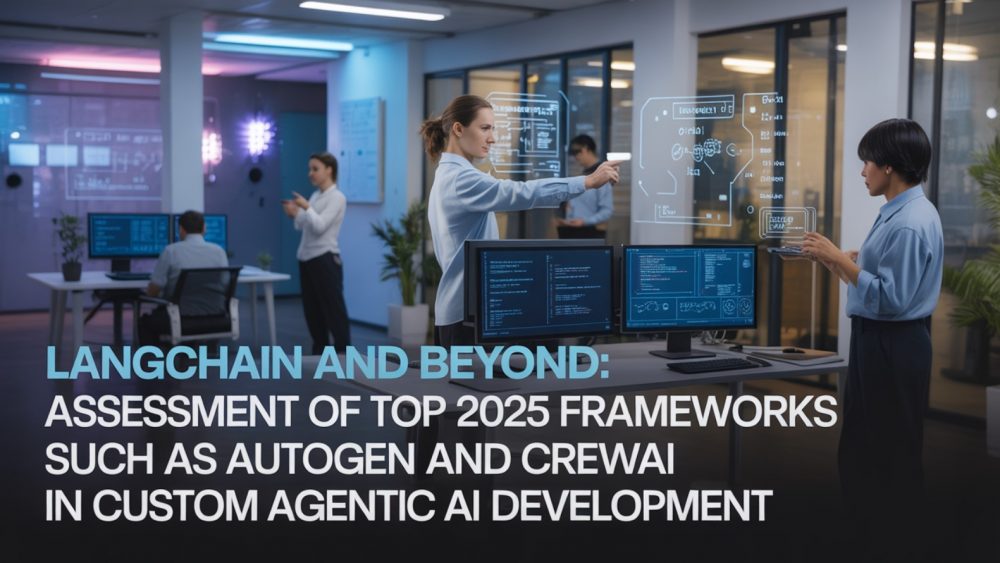The AI agent development has completely changed its landscape, and several frameworks are fighting over developer mindshare. Both as an independent developer and in collaboration with an agentic AI development company.
It is important to understand the specifics between such platforms as LangChain, AutoGen, and CrewAI to build a more advanced autonomous system.
This discussion will cover both the LangChain vs AutoGen framework argument and other up-and-coming applications that will enable you to make decisions that are informed decisions when developing your own agentic AI projects.
Learning the Contemporary AI Agents Frameworks
The emergence of large language models has offered new possibilities in the development of intelligent, autonomous systems like never before. These are the best AI agent systems in development, which offer the developers the platform to develop agents capable of reasoning, planning, and performing complex tasks with minimal human involvement. The most important distinction between the best frameworks of AI agents in the year 2025 is in the approach towards AI agent architecture and design. Others value simplicity and quick prototyping, whereas others emphasize production-level reliability and enterprise-level scaleability.
LangChain VS AutoGen Framework: Architectural Differences
In the comparison of the LangChain vs AutoGen framework, basic architectural philosophies are immediately evident. One of the first general frameworks was LangChain, which provided a modular structure that is based on composable parts: chains, agents, tools, and memory systems. The design is capable of mixing and matching components depending on specific requirements, doing well to produce linear workflows and decision trees.
AutoGen, created by Microsoft Research, is also based on a radically different solution in the form of multi-agent collaboration systems. AutoGen is designed to allow developers to produce multiple specialized agents communicating and collaborating via conversation-driven dialogue as opposed to producing single agents with a complex internal logic.
LangChain vs AutoGen, there are many times when the decision will depend upon your use case. LangChain is better when there is a strong need to integrate with external data sources, has intricate retrieval-augmented generation pipelines, or consists of one intelligent agent coordinating multiple tools. AutoGen is bright in those cases where collaborative problem-solving is necessary, and when the problem can be improved through multi-agent dialogue or when specialization of roles is helpful.
Comparison of CrewAI and AutoGen: Specialized Multi-Agent Approaches
The comparison of CrewAI and AutoGen shows that there are two different philosophies of multi-agent system design. CrewAI proposes crews – groupings of AI agents collaborating with their roles, goals, and processes. Consider it a virtual organization with each agent being assigned certain roles. The content creation team may consist of a researcher, writer, and editor agents with specific tools and knowledge.
AutoGen is more discourse-based and less authoritative. There are free-flowing discussions amongst agents, and the structure takes care of turn-taking and ending the conversation. This forms emergent behavior so that solutions are created due to interactions among the agents and not a pre-established workflow.
For custom agentic AI development, this comparison underscores a significant decision: structured, repeatable workflows with defined role definitions (CrewAI), or flexible, conversation-driven problem-solving that changes with context (AutoGen). CrewAI is more likely to thrive in a production environment and AutoGen in a research environment because of its predictability and flexibility, respectively.
LangChain vs. AutoGen Framework: Integration Ecosystems
The third significant factor in the LangChain vs AutoGen framework analysis is maturity in an ecosystem. LangChain supports a wide range of integrations of vector databases, document loaders, API wrappers, and specialized tools. This full ecosystem saves a lot of time in the development process of the applications that communicate with various external services.
AutoGen has a lighter-weight approach to integrations, placing more emphasis on core agent communication infrastructure. Although it favors fewer out-of-the-box integrations than LangChain, it gives the option of flexible mechanisms for creating custom tools.
The real-world implication: when your project involves large amounts of data input (through various sources) or the ability to coordinate and coordinate a large number of external APIs, LangChain’s wide-ranging integration library can be of considerable benefit. AutoGen has a more simplified design that can be useful in applications where the reasonableness and coordination of agents are the main complexities.
Getting to know the LangChain Alternatives 2025
Other than the LangChain vs AutoGen framework debate, the LangChain alternatives ecosystem 2025 has grown significantly. The Semantic Kernel framework by Microsoft connects enterprise .NET environments to modern AI systems. LlamaIndex (formerly GPT Index) specializes in data indexing and retrieval, using advanced indexing mechanisms optimized for different scenarios.
Another alternative that has especially high support for production deployments and search-oriented applications is Haystack.
New Agent Development Tools: The New Wave
The classification of new agent development tools is not restricted to full-fledged frameworks. A recent addition to the LangChain ecosystem, LangGraph represents agent flows as state machines, modeled as graphs, providing more control flow and support for more effective debugging. DSPy is the new paradigm that enables a developer to specify system objectives and apply optimization methods to generate efficient prompts automatically. The observability infrastructure of service (such as AgentOps) is built to overcome the key obstacle to autonomous AI agent tools in production: monitoring and debugging.
Artificial Intelligence Agent Architecture and Design: Success Principles
Irrespective of the choice of the framework, it is essential to grasp the basic principles. Good agents strike the right balance between personal autonomy and a sense of control in such a way that they have some freedom to respond to the unforeseen, though guardrails that fulfill safe behavior.
Effective agent architecture often uses a planning system to break down high-level tasks, a memory system to maintain context during interactions, tools to perform tasks beyond text capabilities, and a reflection system that allows agents to evaluate their own output. Effective tool interfaces have concise capabilities descriptions, specifications of each parameter clearly, and have a strong ability to handle errors.
Multi-Agent Collaboration Systems: Coordination Patterns
The trend in the multi-agent collaboration systems demonstrates an increased acknowledgment that multi-complex issues may be addressed with professional skills. There are a number of coordination patterns that have become best practices:
Hierarchical Pattern: An agent in charge controls and assigns sub-tasks to worker agents, combining the product into the final outcomes. Suits well with problems that are easily decomposable.
Sequential Pattern: Agents link together whereby the output of one agent acts as the input of another agent. This pattern is inherently associated with content pipelines research agent gathers information, the writing agent drafts content, editing agent refines the output.
Pattern of Consensus: Several agents individually process a problem, and the results are combined. This enhances consistency by minimizing personal agent mistakes and exposing different ways of thinking.
Langchain vs. Autogen Framework: Performance and Scalability
The LangChain vs AutoGen framework comparison needs to be able to cover real-world performance issues. The huge abstraction layers found in LangChain give flexibility but may be overbearing. AutoGen has a less bulky architecture, which tends to have lower overhead, but when conversational patterns are multi-agent, the overhead can increase, and the number of tokens used can also increase.
Production Ready Systems: Custom Agentic AI Development
To move to the next stage of developing a prototype into a production-ready custom agentic AI, it is not enough to raise the issue of selecting of framework. The critical point of error handling arises when agents are acting independently – thorough ways of dealing with error are input validation, output validation, timeouts, and graceful degradation. Cost control needs to cache frequently accessed data, utilise less expensive models in the process of mundane tasks, and limit the hard capacity of tokens. Designers must make the user experience transparent by showing the agents’ actions, progress indicators, intermediate results, and reasoning explanations.
Choosing the Right Framework
When choosing one of the LLM-based automation systems, you should take into account your particular needs. Use LangChain when you want a lot of external integrations, building either single-agent systems, mature production patterns or access to biggest ecosystem. Choose AutoGen when the projects can take advantage of the multi-agent cooperation.When the problem resolution should be flexible with the help of conversations. When the infrastructure should be lightweight. Apply CrewAI where you require formal, repeatable multi-agent processes that have well-defined role assignments.
Conclusion
The LangChain vs AutoGen frameworkselection is not just technical decision, but is a good illustration of underlying decisions regarding the way you imagine autonomous systems. The holistic methodology of LangChain offers an effective basis for single-agent systems. The paradigm of conversation by AutoGen provides more flexible patterns of collaboration. The most effective teams tend to utilize several frameworks. The choice of tools depends on this or that need instead of standardization on one platform. The knowledge of the advantages and limitations of both variants of the broadening ecosystem of the best AI agent frameworks. The eyes of developers allows making informed choices between the short-term demands and long-term maintainability.


